The Mate 20 & Mate 20 Pro Review: Kirin 980 Powering Two Contrasting Devices
by Andrei Frumusanu on November 16, 2018 8:10 AM EST- Posted in
- Smartphones
- Huawei
- Mobile
- Kirin 980
- Mate 20
- Mate 20 Pro
Kirin 980 Second Generation NPU - NNAPI Tested
We’ve tested the first generation Kirin NPU back in January in our Kirin 970 review – Back then, we were quite limited in terms of benchmarking tests we were able to run, and I mostly relied on Master Lu’s AI test. This is still around, and we’ve also used it in performance testing Apple’s new A12 neural engine. Unfortunately or the Mate 20’s, the benchmark isn’t compatible yet as it seemingly doesn’t use HiSilicon’s HiAI API on the phones, and falls back to a CPU implementation for processing.
Google had finalised the NNAPI back in Android 8.1, and how most of the time these things go, we first need an API to come out before we can see applications be able to make use of exotic new features such as dedicated neural inferencing engines.
“AI-Benchmark” is a new tool developed by Andrey Ignatov from the Computer Vision Lab at ETH Zürich in Switzerland. The new benchmark application, is as far as I’m aware, one of the first to make extensive use of Android’s new NNAPI, rather than relying on each SoC vendor’s own SDK tools and APIs. This is an important distinction to AIMark, as AI-Benchmark should be better able to accurately represent the resulting NN performance as expected from an application which uses the NNAPI.
Andrey extensive documents the workloads such as the NN models used as well as what their function is, and has also published a paper on his methods and findings.
One thing to keep in mind, is that the NNAPI isn’t just some universal translation layer that is able to magically run a neural network model on an NPU, but the API as well as the SoC vendor’s underlying driver must be able to support the exposed functions and be able to run this on the IP block. The distinction here lies between models which use features that are to date not yet supported by the NNAPI, and thus have to fall back to a CPU implementation, and models which can be hardware accelerated and operate on quantized INT8 or FP16 data. There’s also models relying on FP32 data, and here again depending on the underlying driver this can be either run on the CPU or for example on the GPU.
For the time being, I’m withholding from using the app’s scores and will simply rely on individual comparisons between each test’s inference time. Another presentational difference is that we’ll go through the test results based on the targeted model acceleration type.

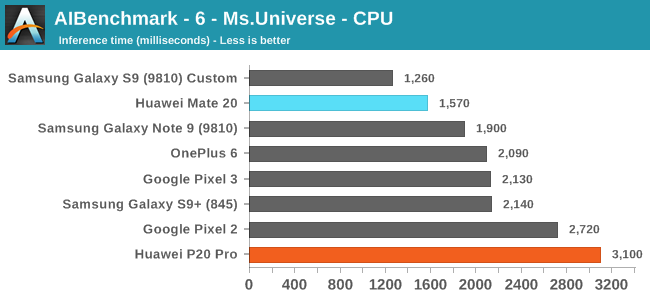
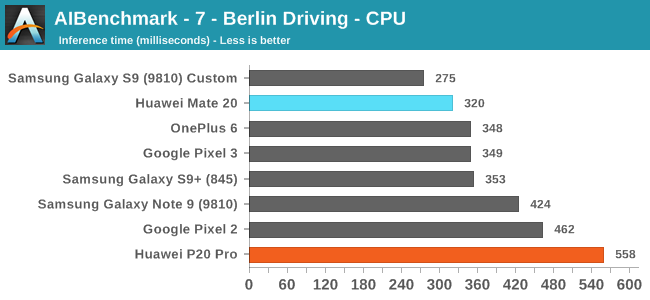
The first three CPU tests rely on models which have functions that are not yet supported by the NNAPI. Here what matters for the performance is just the CPU performance as well as the performance response time. The latter I mention, because the workload is transactional in its nature and we are just testing a single image inference. This means that mechanisms such as DVFS and scheduler responsiveness can have a huge impact on the results. This is best demonstrated by the fact that my custom kernel of the Exynos 9810 in the Galaxy S9 performs significantly better than the stock kernel of the same chip of the Note9 in the same above results.
Still, comparing the Huawei P20 Pro (most up to date software stack with Kirin 970) to the new Mate 20, we see some really impressive results of the latter. This both showcases the performance of the A76 cores, as well as possibly improvements in HiSilicon’s DVFS/scheduler.
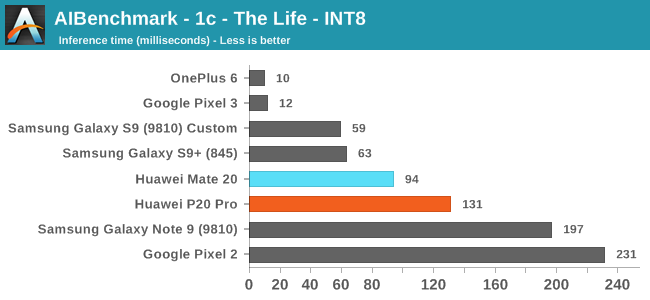
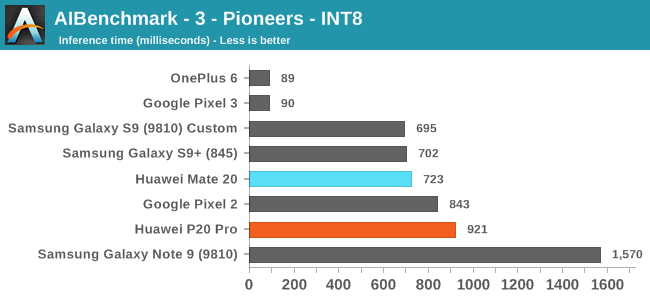
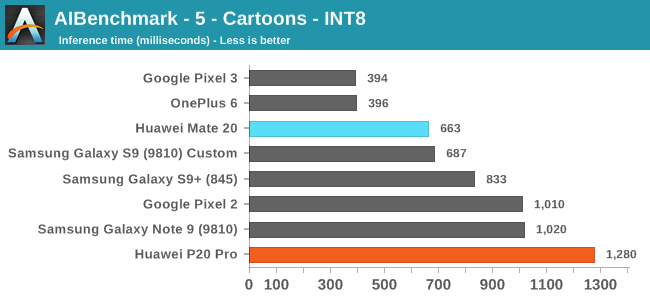
Moving onto the next set of tests, these are based on 8-bit integer quantized NN models. Unfortunately for the Huawei phones, HiSilicons NNAPI drivers still doesn’t seem to expose acceleration to the hardware. Andrey had shared with me that in communications with Huawei, is that they plan to rectify this in a future version of the driver.
Effectively, these tests also don’t use the NPU on the Kirins, and it’s again a showcase of the CPU performance.
On the Qualcomm devices, we see the OnePlus 6 and Pixel 3 far ahead in performance, even compared to the same chipset Galaxy S9+. The reason for this is that both of these phones are running a new updated NNAPI driver from Qualcomm which came along with the Android 9/P BSP update. Here acceleration if facilitated through the HVX DSPs.
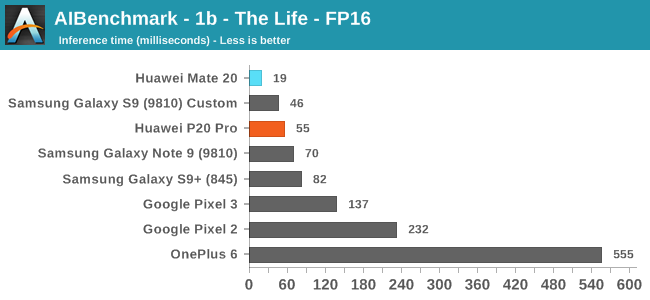
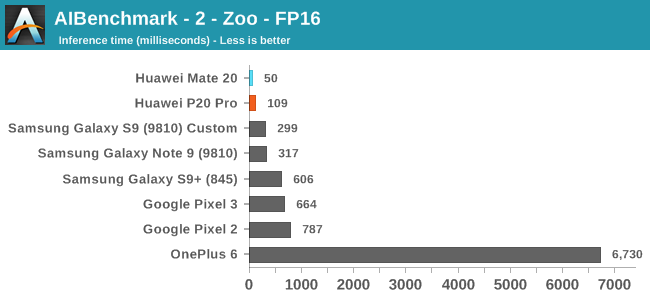
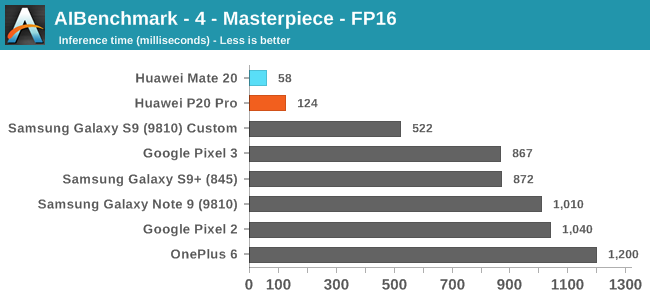
Moving on to the FP16 tests, here we finally see the Huawei devices make use of the NPU, and post some leading scores both on the old and new generation SoCs. Here the Kirin 980’s >2x NPU improvement finally materialises, with the Mate 20 showcasing a big lead.
I’m not sure if the other devices are running the workloads on the CPU or on the GPU, and the OnePlus 6 seems to suffer from some very odd regression in its NNAPI drivers that makes it perform an order of magnitude worse than other platforms.

Finally on the last FP32 model test, most phones should be running the workload on the CPU again. There’s a more limited improvement on the part of the Mate 20.
Overall, AI-Benchmark was at least able to validate some of Huawei’s NPU performance claims, even though that the real conclusion we should be drawing from these results is that most devices with NNAPI drivers are currently just inherently immature and still very limited in their functionality, which sadly enough again is a sad contrast compared where Apple’s CoreML ecosystem is at today.
I refer back to my conclusion from early in the year regarding the Kirin 970: I still don’t see the NPU as something that obviously beneficial to users, simply because we just don’t have the software applications available to make use of the hardware. I’m not sure to what extent Huawei uses the NPU for camera processing, but other than such first-party use-cases, NPUs currently still seems something mostly inconsequential to device experience










141 Comments
View All Comments
id4andrei - Friday, November 16, 2018 - link
Have to say, did not expect Huawei of all companies to correctly ape FaceID. I thought that Android OEMs would not be able to compete as Apple bought the OG Kinect company for that. That's serious talent.s.yu - Friday, November 16, 2018 - link
I'm beginning to think Huawei's making this watercolor texture their new hallmark. They can't solve the texture problem with their 1/1.7" 40MP flagship so any smaller modules are intentionally crippled? LG is bad though, LG's the only company delivering consistently worse texture than Huawei.I remember the Mate20P outperforming P20P in terms of texture from samples elsewhere, yet here the tables turn. Very bad QC and a bad lens sample? Or maybe the P20P is a surprisingly good copy, from impression it usually smears more than this.
Don Hrle - Friday, November 16, 2018 - link
Is performance mode capable of sustained system and gaming performance? I've seen in other review saying phone is prone to significant heating and throttling then.Andrei Frumusanu - Friday, November 16, 2018 - link
All the results here are in performance mode.iwod - Friday, November 16, 2018 - link
I like it where we finally come to the conclusion, OLED isn't power efficient. I just wish we have better LCD tech so we don't have to live with PWM Display.How much does actual Mate 20 / Pro cost in retail? Surely those are listed prices and they are not going to really sell it at those price right? Those are crazy Apple price range.
iwod - Friday, November 16, 2018 - link
And I hate to say this.... I like the Mate 20 Camera quality photos then the iPhone XS. I really really dislike some of the tone and colouring Apple decided to use with its Camera.Chitti - Friday, November 16, 2018 - link
Mate 20 Pro on Smart or 1080p or 1440p ?Chitti - Friday, November 16, 2018 - link
And what about the In display FPS, even it consumes battery.1hr more battery life if it's disabled.
Andrei Frumusanu - Friday, November 16, 2018 - link
It wasn't active at the time of the battery tests.Andrei Frumusanu - Friday, November 16, 2018 - link
1440p.